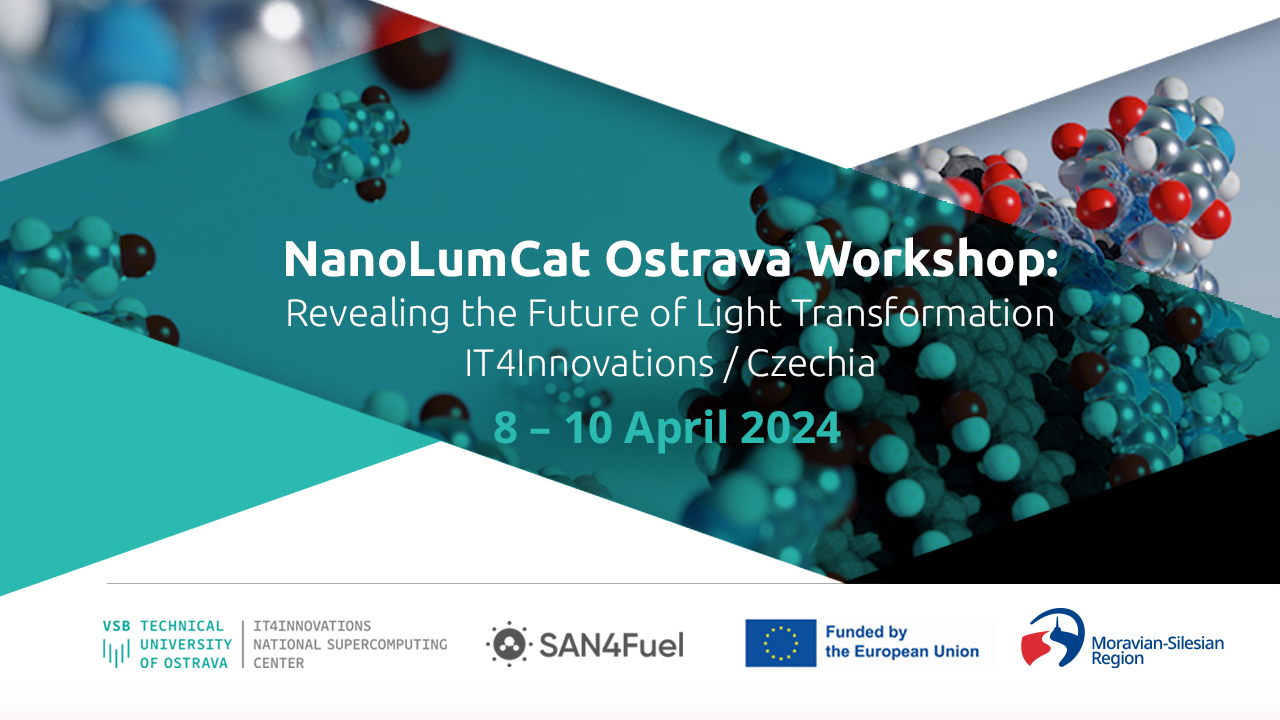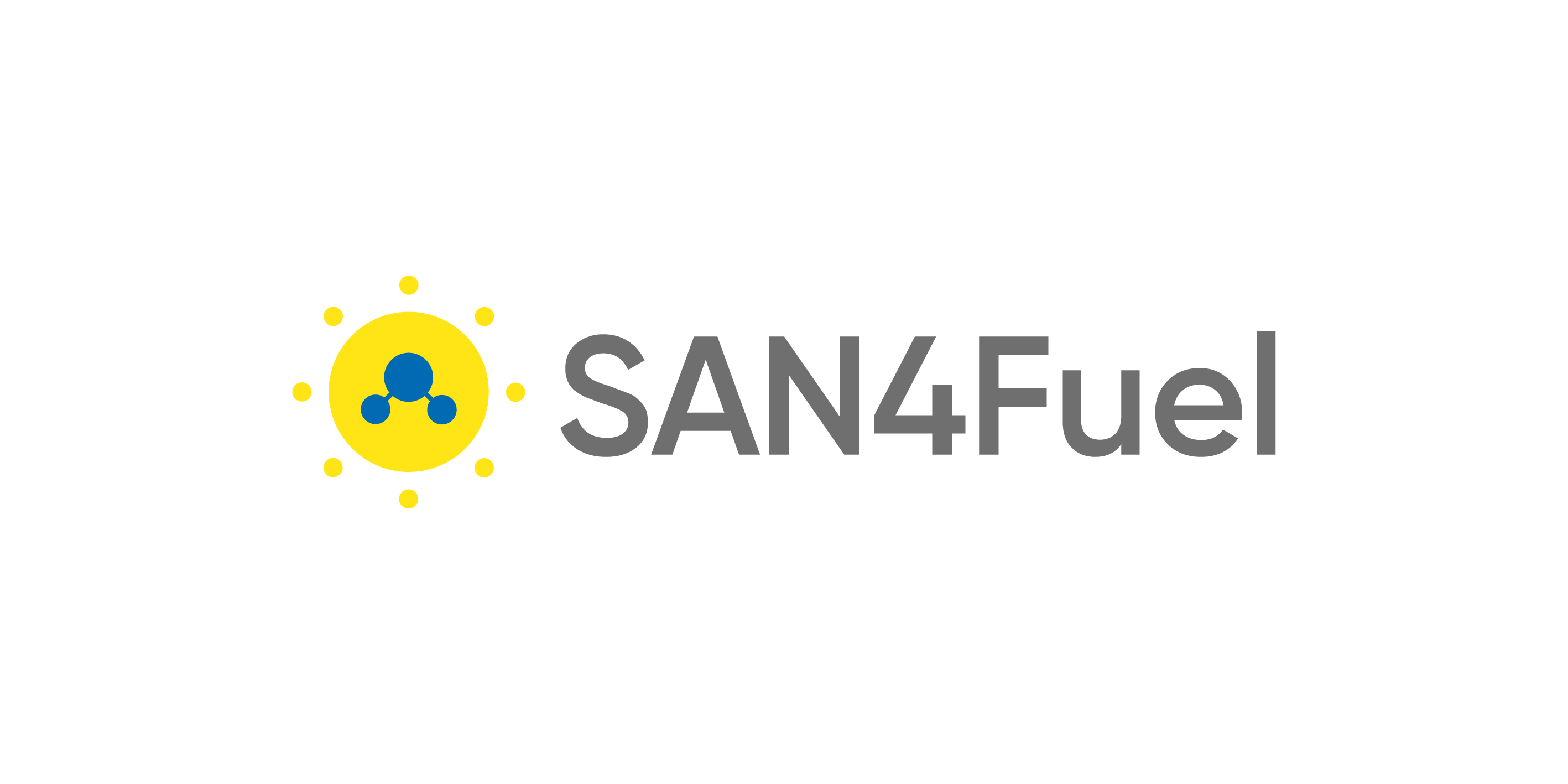 NanoLumCat Ostrava Workshop: Revealing the Future of Light Transformation
NanoLumCat Ostrava Workshop: Revealing the Future of Light Transformation
When: 8 – 10 April 2024
Where: IT4Innovations National Supercomputing Center
Welcome to the "NanoLumCat Ostrava Workshop: Revealing the Future of Light Transformation" where leading experts in the fields of carbon dots and single atom photocatalysis unite to broaden the horizons of nanomaterial science with a focus on renewable energy applications. The workshop invites participants to dive deep into the exciting worlds of carbon dots and single atom-based photo(electro)catalysis. From synthesis techniques to cutting-edge applications, participants will engage in insightful discussions, uncovering the latest advancements in photoinduced carbon dots and single atom catalysis research areas. This year under the umbrella of the SAN4Fuel project and Global Experts programme. Join us in Ostrava for an enlightening journey into the future of nanotechnology and renewable energy, where NanoLumCat aims to ignite a new era of scientific breakthroughs and technological advancements in the field of nanomaterials for sustainable development.
Confirmed speakers:
Prof. Dirk M. Guldi: Rational Design of Carbon Dots for Photocatalysis
Professor Dirk M. Guldi is a prominent figure in photochemistry, currently serving as a professor at Friedrich-Alexander University Erlangen-Nürnberg, Germany. He received his Ph.D. in Chemistry from the University of Cologne in 1994, focusing on photoactive materials. His postdoctoral work took him to the National Institute of Standards and Technology in the US, where he enhanced his expertise in molecular electronics. In 1997, he joined the University of Notre Dame as a research professor and later moved to Friedrich-Alexander University as a full professor in 2004. Professor Guldi's research specializes in nanotechnology, particularly in developing carbon-based materials like fullerenes and carbon dots, mainly for solar harvesting applications. His work, which has led to over 600 publications and an h-index of 118, bridges physical chemistry and materials science, emphasizing the photophysical and electrochemical properties of these materials.
Prof. Leticia Gonzales: How to compute UV optical properties in molecular systems
Professor Leticia González is a distinguished theoretical chemist and academic leader, currently serving as the Head of the Institute of Theoretical Chemistry at the University of Vienna. Born in 1971 in Madrid, Spain, she earned her Bachelor's degree in Chemistry from the Universidad Autónoma de Madrid and completed her Ph.D. with honors in Chemistry in 1998. With a research focus on highly accurate electronic structure methods and molecular reaction dynamics, Professor González bridges these fields to gain a fundamental understanding of chemical processes, structure-function relationships, and to make quantitative predictions in diverse areas. Her exceptional contributions have earned her numerous accolades, including the Dirac Medal from the WATOC, the Prize for Excellence from the Spanish Royal Society of Chemistry, and an Honoris Causa doctorate from the University of Lorraine. As a full member of the Austrian Academy of Sciences, corresponding member of the Göttingen Academy of Sciences and Humanities, and author of over 300 publications, Professor Leticia González continues to shape the landscape of theoretical chemistry through her visionary research and leadership.
Prof. Andrey Rogach: Chiral Carbon Dots
Professor Andrey L. Rogach is a Yeung Kin Man Chair Professor of Photonics Materials at the Department of Materials Science and Engineering, and the Founding Director of the Centre for Functional Photonics (CFP) at City University of Hong Kong. He received his Diploma in Chemistry (1991, with honors) and Ph.D. in Physical Chemistry (1995) from the Belarusian State University in Minsk studying formation and properties of silver nanoparticles in different media. He worked as a postdoc (with Horst Weller) and then as a staff scientist at the Institute of Physical Chemistry of the University of Hamburg, Germany from 1995 to 2002. From 2002–2009 he held a tenured position of a lead staff scientist at the Department of Physics and Centre for NanoScience of the University of Munich, Germany, where he completed his habilitation in Experimental Physics on light emission and harvesting with semiconductor nanocrystals. He joined the City University of Hong Kong as a Full Professor in 2009 and was advanced to Chair Professor in 2012. His research focuses on the synthesis, assembly, and optical spectroscopy of colloidal semiconductor and metal nanocrystals and their hybrid structures and their use for energy-related applications. He authored over 550 scientific publications (h-index 2023: 138) in these fields that have been extensively (over 70,000) cited, which him as Highly Cited Researcher (Clarivate Analytics) – Cross-Field 2018 & 2019 and Material Science 2020-2022. His distinctions include the RGC Senior Research Fellowship (Hong Kong, 2023), the Croucher Senior Research Fellowship (Hong Kong, 2019), the Carl Friedrich von Siemens Research Award of the Alexander-von-Humboldt Foundation (Germany, 2018), the CityU President’s Award (2017), the Alexander von Humboldt Fellowship (Germany, 2000), the Ikerbasque Fellowship of the Basque Country (Spain, 2012), the Grand Research Excellence Award from City University of Hong Kong (2011), the Walton Award from the Science Foundation Ireland (2005), as well as NRC COBASE (USA, 1999), British Telecom (UK, 1998) and DAAD (Germany, 1995) Fellowships. He holds honorable appointments at Trinity College Dublin (Ireland), Xi’An Jiaotong University, and Soochow University (China). Andrey Rogach is a Foreign Member of the Academia Europaea, and a Fellow of the Electromagnetic Academy, USA. He served as an Associate Editor of ACS Nano in 2011-2023.
Prof. Paolo Fornasiero: Carbon structures with "more or less" active metals
Paolo Fornasiero is Full Professor of Inorganic Chemistry at the University of Trieste. The scientific interests of Paolo Fornasiero are in the field of inorganic chemistry, with attention to the design and development of multi-functional nano-systems for their advanced applications in energy related processes and environmental heterogeneous catalysis. Paolo Fornasiero has published more than 300 research articles, 19 book chapters, and holds 4 patents. Since 2022 he is member of the Academia Europaea and from 2021 he is member of the European Academy of Sciences. He received various awards including the 2005 Nasini Medal, the 2013 Chiusoli Medal from the Italian Chemical Society, the 2016 Heinz Heinemann Award from the International Association of Catalysis Societies, and the 2022 Malatesta awards from the Italian Chemical Society.
Dr. Michele Melchiona: The impact of metal single atoms in carbon nitride photocatalysis for organic synthesis
Michele Melchionna obtained his degree in chemistry in 2002 at the University of Salerno and his PhD in 2006 at the Edinburgh University. He pursued his interest in chemistry and science by working in different contexts and thus gaining experience outside academia: he worked as a Higher Scientific Officer at Food Standard Agency (London, UK), where he also acted as UK representative at Working Groups of Experts of the European Commission, and as a Senior R&D Chemist at Advanced Molecular Technologies (Melbourne, Australia). He was recipient of post-doctoral fellowships in catalysis for organic synthesis at the University of Helsinki (Finland) and at the Palacky University (Olomouc, Czech Republic). After more than 10 years of international experience he moved back to his native Italy in 2013, where he is currently Associate Professor at the Department of Chemical and Pharmaceutical Sciences at the University of Trieste. His research interests include the rational assembly of nanohybrid materials for heterogeneous catalysis, in particular for Energy-related catalytic processes (photocatalysis and electrocatalysis) and heterogeneous catalysis for organic synthesis, focusing on the understanding of the structure/activity relationship. In each of the last three years, he appeared in the 2% Elsevier/Stanford ranking of most cited scientists across the world.
Organizers
Prof. Michal Otyepka, Assoc. Prof. Štěpán Kment and Dr. Michal Langer
Professor Michal Otyepka, Ph.D. (born 1975), serves as the Head of the Modelling for Nanotechnology Lab at IT4Innovations, VSB-TUO, and concurrently holds the position of Head of the CATRIN-RCPTM research division at Palacký University in Olomouc. Additionally, he is a member of the Scientific Board of the Czech Grant Agency and the LUMI Supercomputer in Finland. Prof. Otyepka's extensive research portfolio encompasses the exploration of the physical-chemical properties and reactivity of graphene derivatives and 2D materials, as well as non-covalent interactions with 2D materials and the photoluminescent properties of carbon dots. His pioneering work involves advancing the chemistry of fluorographene (2D chemistry) towards graphene derivatives with applications in biosensing, catalysis, and energy storage. Proficient in the modeling of biomolecules, nanomaterials, and complex molecular systems, he specializes in the development of force fields, multiscale methods, and their practical applications. Prof. Otyepka serves as the principal investigator for an ERC – Consolidator grant, three ERC Proof of Concept grants, and EIC Transition grants. He is the author or co-author of over 300 papers in international journals, three book chapters, and one book.
Assoc. Prof. Štěpán Kment
Assoc. prof. Štěpán Kment received his PhD in solid state physics and photoelectrochemistry in 2010 from Czech Technical University in Prague, Czech Republic. He then spent one year as a postdoctoral research fellow at Department of Electrical Engineering, University of Nebrasca – Lincoln, Lincoln, NE, USA. Since 2011 he has been working at Palacky University, Olomouc, Czech Republic as a group leader of Photoelectrochemistry. In addition, He is also working at VSB - Technical University of Ostrava, Czech Republic. His research is focused on development of new materials and nanostructures for PEC water splitting and other renewable energy applications. Assoc. Prof. Kment has been serving as the principal investigator for several prestigious grants including one European project within the REA Twinning call. He is the author or co-author of over 150 papers in international journals, one book chapters, and one US patent.
The Global Experts Programme is supported by the Moravian-Silesian Region.

The SAN4Fuel Project is funded by the European Union.


For transport, accommodation see https://www.it4i.cz/en/how-to-get-to-it4innovations
